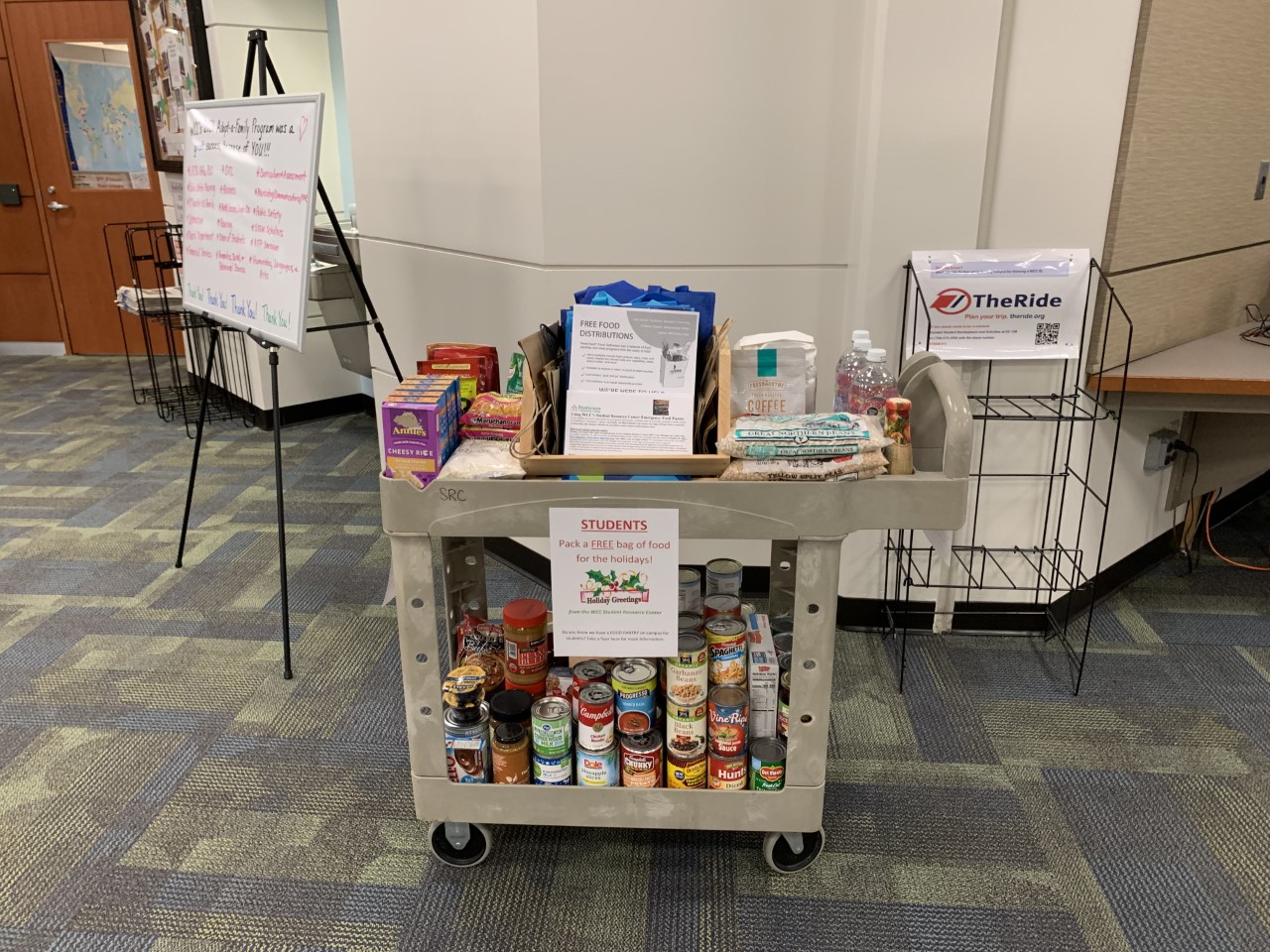
Students can fill a FREE bag of food for the holidays. Courtesy of Carol Tinkle.
By Willow Symonds
Staff Writer
Community colleges all over the state are developing their own food cupboards. While each place may or may not use a literal cupboard, they all serve the same purpose: supply food and other items to students in emergency situations.
Opening their cupboard – then called a food pantry – 18 years ago, WCC was one of the first Michigan community colleges to have this resource.
The Student Resource Center operates a food cupboard on the Student Center’s second floor. Food insecure students can either fill out the website’s form or let the Counseling Counter’s faculty know of their situation. In return, students can pick up two bags of food and some items of their choice, such as hygiene products like dental floss and toilet paper.
COVID-19 changed many aspects of the cupboard. Donation amounts are less than they were a few years ago. Before the pandemic, dozens of students would take food and other items per week, but now the numbers have dropped to one or two students a week.
While a nice theory would be food income becoming more secure among the Washtenaw population, Debra Guerrero, director of Learning Support Services, attributes this decrease to more off-campus classes and less knowledge of the cupboard’s existence.
For this reason, Carol Tinkle, project and data technician at the Student Resource Center and Career Technical Education, combined the cupboard’s service with advertising.
On the same floor as the Counseling Counter, more often around Thanksgiving and the winter holidays, she sits a cart for students to walk by and notice the canned and boxed food. If they’re drawn in and go closer, they can read the sign that tells them to take a paper bag and pack it with free food – emphasis on the “FREE” part.
Tinkle believed that the cart would both inform people of the cupboard and give shy or embarrassed students food without them having to ask.
Unlike the cart, when students take food from the Counseling Counter, they have to show their student ID. A caseworker may later approach them to learn of their other needs, such as child care assistance and bus tokens. But with the cart, they can bag their own items anonymously and they can continue their lives like before, only with a fuller belly.
Since November is National Homeless Youth Awareness Month, Tinkle will have the cart on the Student Center’s second floor every weekday.
However, the cart and the bulletins around campus aren’t just for students in need to see, but are also for lucky students who don’t need it. These students can help keep the cupboard running. How? By donating essential items, which is where the cupboard gets its supply, from both faculty and students.
Guerrero said that the best food items to donate are, “non-perishable and canned items. Same with things already prepared, like rice and soup. This year Carol [Tinkle] looked up and developed meal kits. One of them is just a breakfast thing, [with] cereal and milk. [Another is] pancake mix.” These meal kits come in cylinder containers, so watch out for those.
Pre-made foods are most valued because they don’t require cooking appliances, which are luxuries not everyone have, especially students receiving food from the cupboard. Despite the food cupboard’s name, students also request non-edible items, such as toothpaste, toothbrushes, shampoo, feminine hygiene products (like pads and tampons), and more that can be found on the cupboard’s website.
Donations go to SE206, where Tinkle works. Tinkle writes the names of who donated on a board, which helps remind people to keep coming back. Some of them are regular donors, and sometimes people just overbought on food one time, according to Guerrero.
“Please bring in non-expired items,” Guerrero advised. “Sometimes people are cleaning out their cupboard and they might think that they’re doing a good thing, but they might bring in something expired.”
She also said that the best containers are unbreakable, such as hard plastic instead of glass. When reviewing what to donate, students and faculty should go through this checklist: long-lasting, quick preparation, and packaged well.
Over the semesters, the cupboard may shift its advertising styles or its availability or even its name; the Student Resource Center only changed it from the pantry to the cupboard earlier this year after discovering that most other community colleges called theirs by the latter. Either way, its original purpose will always remain: helping students get what they need to learn and live like everyone else.

